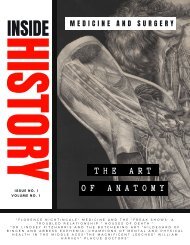InsideHistoryDigital
You also want an ePaper? Increase the reach of your titles
YUMPU automatically turns print PDFs into web optimized ePapers that Google loves.
Of all the images we have of the plague, that of the<br />
plague doctor is perhaps the most familiar – and<br />
certainly one of the most chilling. The sight of a<br />
solitary figure wearing a beak-like mask, slowly<br />
making its way from infected house to infected<br />
house must have been a disturbing sight to witness<br />
in the streets of any plague-ridden city or town.<br />
Indeed, not only is the figure of the plague doctor<br />
synonymous with the plague, it has become a<br />
personification of death itself.<br />
The French physician Charles de Lorme is credited<br />
with inventing the familiar ‘beak doctor’ costume in<br />
1619 or 1620, in order to minimise the risk of<br />
contracting the dreaded disease himself. Lorme<br />
had need of protection. As the personal physician<br />
to the Medici family, he practiced medicine in<br />
Florence, Milan and Naples, three of the worstaffected<br />
cities in seventeenth-century Europe.<br />
Lorme wrote of his outfit’s distinctive mask thus:<br />
“nose half a foot long, shaped like a beak, filled with<br />
perfume with only two holes, one on each side near<br />
the nostrils, but that can suffice to breathe and to<br />
carry along with the air one breathes the<br />
impression of the drugs enclosed further along in<br />
the beak.”<br />
The drugs he refers to in the beak of the mask were<br />
strong-smelling herbs, spices and dried flowers (the<br />
posies referred to in the seemingly innocent<br />
nursery rhyme) which supposedly prevented the<br />
inhalation of miasma – the bad air which for<br />
centuries was thought to be one of the key causes<br />
of the plague.<br />
For every high-profile plague doctor like Lorme<br />
there were thousands of untrained and<br />
inexperienced pseudo-physicians, known as<br />
empirics, who valiantly tried in vain to ease the<br />
suffering of their family, friends and neighbours<br />
afflicted by one of the worst diseases in human<br />
history. Many of them died while doing so. Lacking<br />
even the most basic scientific knowledge and<br />
understanding of the real cause, transmission and<br />
spread of the plague, the methods plague doctors<br />
used to treat their patients ranged from the<br />
sensible to the ludicrous.<br />
The first thing to do was to isolate the patient and<br />
fumigate their house. There are numerous<br />
accounts of whole families being locked in their<br />
homes, the healthy with the sick, such was the<br />
desperation to prevent the plague from spreading.<br />
If the patient or their family could afford one, a

















